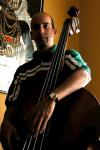© 2009 Gerardo A. Sanchez, All Rights Reserved.
Tempo
In musical terminology, tempo (Italian for time) is the speed or pace of a given piece. It is a crucial element of composition, as it can affect the mood and difficulty of a piece. The plural of tempo is tempi.
The tempo of a piece will typically be written at the start of a piece of music, and in modern music is usually indicated in beats per minute (BPM). This means that a particular note value (for example, a quarter note or crotchet) is specified as the beat, and the marking indicates that a certain number of these beats must be played per minute. The greater the tempo, the larger the number of beats that must be played in a minute is, and, therefore, the faster a piece must be played. Mathematical tempo markings of this kind became increasingly popular during the first half of the 19th Century, after the metronome had been invented by Johann Nepomuk Mälzel, although early metronomes were somewhat inconsistent. Beethoven was the first composer to use the metronome, and in 1817 he published metronomic indications for his (then) eight symphonies. Unfortunately, the metronome markings on his "Hammerklavier" Sonata and Ninth Symphony are almost impossibly fast, as is also the case for many of the works of Schumann.
(Tempo info taken from wikipedia)
Lat: 8° 35' 2.55" N
Long: 72° 10' 35.96" W
Elevation: 1800
Precision is: Unknown / Undeclared.



 Tap or click the zoom icon in the bottom right corner of the picture to switch between in-page and fullscreen view
Tap or click the zoom icon in the bottom right corner of the picture to switch between in-page and fullscreen view